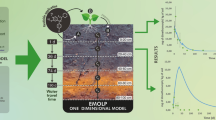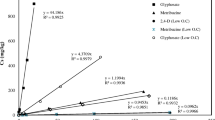Abstract
A semi-empirical probabilistic transport model was developed to simulate simazine and diuron well water concentrations in an agriculturally intensive coarse soil region of Fresno County, California. Model inputs included five random variables: the organic carbon normalized soil adsorption coefficient, root zone degradation, application rate, depth to ground water, and ground water recharge age. Transport was simulated in two phases: initial transport through the root zone using the mechanistic model LEACHM, and a second empirically-based phase that simulated transport from the bottom of the root zone to the water table, and ultimately to domestic water wells. Best-fit calibration estimates for combined deep vadose/shallow ground water degradation half-lives were 330 d and 455 d for simazine and diuron, respectively. Simulations based on these fitted half-lives yielded coefficients of determination and root mean square errors of 0.973 and 0.993, and 0.367 and 0.364 for observed vs predicted simazine and diuron concentration percentiles, respectively. The calibrated model output also described the observed relationships of decreasing detection frequency and decreasing concentration with increasing depth to ground water. A novel contribution is the calculation of regional mass budgets for the herbicides. In modeling results, 9–54% and 2–16% (10th–90th percentiles) of applied simazine and diuron, respectively, leached out of the 1.5 m root zone, while the upper 10th percentile of well water concentrations corresponded to approximately 1–2% of application for both pesticides.
Similar content being viewed by others
References
Burow, K.R., Panshin, S.Y., Dubrovsky, N.M., Vanbrocklin, D., & Fogg, G.E. (1999). Evaluation of Processes Affecting 1,2-Dibromo-3-Chloropropane (DBCP) Concentrations in Ground Water in the Eastern San Joaquin Valley, California: Analysis of Chemical Data and Ground-Water Flow and Transport Simulations. U.S. Geological Survey pub. WRI 99-4059, pp. 57.
Busenberg, E., & Plummer, L.N. (1992). Use of chlorofluorocarbons (CCl3F and CCl2F2) as hydrologic tracers and age-dating tools: The alluvium and terrace system of Central Oklahoma. Water Resour. Res., 28, 2257–2283.
California Agricultural Technology Institute. (1988). Irrigation systems and water application efficiencies. CATI Center for Irrigation Technology, publication 880104. California: California State University, Fresno, pp. 6.
Campbell, G. (1974). A simple method for determining unsaturated conductivity from moisture retention data. Soil Science, 117, 311–314.
CDPR. (2005). 1990–2003 electronic Pesticide Use Data, California Department of Pesticide Regulation, available on-line: http://www.cdpr.ca.gov/docs/pur/purmain.htm, verified November 1, 2005.
Cook, P.G., Solomon, D.K., Plummer, L.N., Busenberg, E., & Schiff, S.L. (1995). Chlorofluorocarbons as tracers of ground water transport processes in a shallow, silty sand aquifer. Water Resour. Res., 31, 425–434.
Decisioneering. (2005). Crystal Ball 7.1 User Manual. Denver CO, pp. 366.
DWR. (1983). The California Water Plan: projected use and available water supplies to 2010. California Department of Water Resources Bulletin, 160–83, pp. 268.
DWR. (1994). California Water Plan Update. California Department of Water Resources Bulletin, 160–93, vol. 2, pp. 315.
Garretson, C. (1999). Protocol 182: Monitoring the Concentration of Detected Pesticides in Wells Located in Highly Sensitive Areas. Environ. Monitoring Branch, California Dept. Pesticide Regulation. available on-line: http://www.cdpr.ca.gov/docs/empm/pubs/protocol.htm, verified November 1, 2005.
Gronberg, J.M., Dubrovsky, N.M., Kratzer, C.R., Domagalski, J.L., Brown, L., & Burow, K. (1998). Environmental Setting of the San Joaquin-Tulare Basins, California. U.S. Geol. Survey pub. WRI 97-4205, Sacramento, CA, pp. 45.
Helsel, D.R., & Hirsch, R.M. (1991). Statistical methods in water resources. U.S. Geological Survey, pp. 524, available online: http://water.usgs.gov/pubs/twri/twri4a3/, verified November 1, 2005.
Hutson, J.L., & Wagenet, R.J. (1992). LEACHM, Leaching Estimation and Chemistry Model version 3. Research Series No. 92-3, Dept. of Soil, Crop, and Atmospheric Sciences, Cornell University, Ithaca, New York.
Johnson, W.G., & Lavy, T.L. (1994). In-site dissipation of benomyl, carbofuran, thiobencarb, and triclopyr at three soil depths. J. Env. Qual., 23, 556–562.
Kordel, W., Wahle, U., Knoche, H., & Hund, K. (1995). Degradation capacities of chlorotoluron and simazine in subsoil horizons. Sci. Tot. Environ., 171, 43–50.
Kruger, E.L., Somasundaram, L., Kanwar, R.S., & Coats, J.L. (1993). Persistence and degradation of 14C-atrazine and 14C-deisopropylatrazine as affected by soil depth and moisture conditions. Env. Tox. Chem., 12, 1959–1967.
Loague, K., & Green, R.E. (1991). Statistical and graphical methods for evaluating solute transport models: Overview and application. J. Contam. Hydrol., 7, 51–73.
Miller, J.L., Wollum, A.G., & Weber, J.B. (1997). Degradation of carbon-14-atrazine and carbon-14-metolachlor in soil from four depths. J. Environ. Qual., 26, 633–638.
Miller, R.J., Biggar, J.W., & Nielsen, D.R. (1965). Chloride displacement in Panoche clay loam in relation to water movement and distribution. Water Resources Res., 1,63–73.
Oster, J.D., Willardson, L.S., & Hoffman, G.J. (1972). Sprinkling and ponding techniques for reclaiming saline soils. Transactions ASCE, 15, 1115–1117.
Rawls, W.J., & Brakensiek, D.L. (1985). Agricultural Management Effects on Soil Water Retention. In: DeCoursey, D.G. (eds), Proceedings of the 1983 Natural Resources Modeling Symposium, USDA-ARS, pp. 532.
Schuette, J., Weaver, D., Troiano, J., Pepple, M., & Dias, J. (2003). Well Inventory Database, Cumulative Report 1986–2003. Environ. Monitoring Branch pub. EH03-08, Dept. Pesticide Regulation, Sacramento CA, pp. 151. Available online: http://www.cdpr.ca.gov/docs/empm/pubs/ehapreps. htm/.(verified November 1, 2005).
Snyder, R.L., Hanson, B.R., & Coppock, R. (1986). How farmers irrigate in California. Univ. of Calif. Division of Ag., & Nat. Res., Leaflet 21414. Oakland, Calif., pp. 6.
Snyder, R.L., Orang, M., Bali, K., & Eching, S. (2005). Basic Irrigation Scheduling. University of California. Available on-line: http://biomet.ucdavis.edu/irrigation_scheduling/bis/BIS.htm, (verified November 1, 2005).
Spurlock, F, Burow, K., & Dubrovsky, N. (2000). Chlorofluorocarbon dating of herbicide containing well waters in Fresno and Tulare Counties. California. J. Env. Qual., 29, 474–483.
Troiano, J., Garretson, C., Krauter, C., Brownell, J., & Hutson, J. (1993). Influence of amount and method of irrigation water application on leaching of atrazine. J. Environ. Qual., 22, 290–298.
Troiano, J., Weaver, D., Marade, J., Spurlock, F., Pepple, M., Nordmark, C., & Bartkowiak, D. (2001). Summary of Well Water Sampling in California to Detect Pesticide Residues Resulting from Nonpoint-Source Applications. J. Environ. Qual., 30, 448–459.
Troiano, J., Marade, J., & Spurlock, F. (1999). Empirical Modeling of Spatial Vulnerabilitiy Applied to a Norflurazon Retrospective Well Study in California. J. Environ. Qual., 28, 397–403.
UC DANR. (1989). Irrigation scheduling. A guide for efficient on-farm water management. University of California, Division of Agricultural and Natural Resources publication 21454, pp. 80.
UCIPM. (2004). University of California Statewide Integrated Pest Management Program, California Weather Data, available on-line: http://www.ipm.ucdavis.edu:/WEATHER/ wxretrieve.html, (verified November 1, 2005).
USDA-ARS. (2005). The Pesticide Properties Database. available on-line: http://www.arsusda.gov/acsl/services/ppdb3/, verified November 1, 2005.
Vanclooster, M., Boesten, J.J.T.I., Trevisan, M., Brown, C.D., Capri, E., Eklo, O.M., Gottesbüren, B., Gouy, V. & van der Linden, A.M.A. (2000). A European test of pesticide-leaching models: methodology and major recommendations. Agricultural Water Management, 44, 1–19.
Watermark Computing. (1998). PEST – Model Independent Parameter Estimation. User's manual. Brisbane, Australia.
Zalkin, F., Wilkerson, M., & Oshima, R.J. (1984). Pesticide movement to ground water volume II: Pesticide contamination in the soil profile at DBCP, EDB, simazine, and carbofuran application sites. Environ. Mon. Branch pub. EH 84-03, Calif. Dept. Pesticide Regulation pub. EH 84-03. Available on-line: http://www.cdpr.ca.gov/docs/empm/pubs/ehapreps.htm/ (verified November 1, 2005).
Zoldoske, D.F. (2002). San Joaquin Valley Grower Irrigation Survey. CSU Fresno Center for Irrigation Technology pub. 021201, pp. 23.
Author information
Authors and Affiliations
Corresponding author
Rights and permissions
About this article
Cite this article
Spurlock, F., Clayton, M. & Das, S.K. Modeling Herbicide Movement to Ground Water in Irrigated Sandy Soils of the San Joaquin Valley, California. Water Air Soil Pollut 176, 93–111 (2006). https://doi.org/10.1007/s11270-006-9151-9
Received:
Accepted:
Published:
Issue Date:
DOI: https://doi.org/10.1007/s11270-006-9151-9




